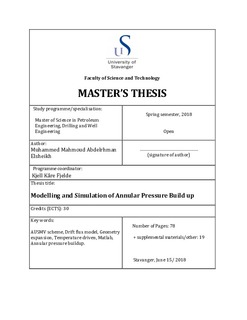| dc.contributor.advisor | Fjelde, Kjell Kåre | |
| dc.contributor.author | Elsheikh, Muhammed Mahmoud Abdelrhman | |
| dc.date.accessioned | 2018-10-24T11:39:27Z | |
| dc.date.available | 2018-10-24T11:39:27Z | |
| dc.date.issued | 2018-06 | |
| dc.identifier.uri | http://hdl.handle.net/11250/2569326 | |
| dc.description | Master's thesis in Petroleum engineering | nb_NO |
| dc.description.abstract | Annular pressure buildup (APB) has been a concern for well design in the recent years. It is a phenomenon that relates mainly to subsea wells with possibly no means to release the pressure building up in closed annuli. Studying the factors, conditions, prediction methods and mitigation techniques are of immense importance to ensure secured drilling and production operations through the entire life of oil and gas wells. The main focus in this thesis is on temperature driven annular pressure build up that can take place in sealed annuli when production is initiated and warm productions fluids are brought to surface.
Modeling of the APB has been considered in the literature and it has been studied by researchers from different perspectives. An important aspect of this phenomenon is the influence of annular pressure buildup on changing the geometry of the annuli in an oil well. As the temperature in the annuli increases it will lead to a thermal expansion of the fluids which again leads to a pressure build up since the fluids will not be allowed to expand if the geometry is fixed. This pressure build up will in turn apply stresses on the surrounding tubing and casing strings that may exceed burst and collapse design limits and can eventually cause a severe failure or abandonment of the well in the worst scenario. However, the pressure build up will also change the geometry of the well. Changing the annular geometrical volumes will limit the pressure build up since some additional volume will be created allowing some real expansion of fluids during the temperature increase. Hence the pressure build up will not be as severe as the most conservative models predict.
Studying and modeling the effect of APB on the annular geometric change is the focal point of this thesis. Based on the drift flux model, a numerical scheme called the AUSMV (The Advection Upstream Splitting Method) is used to perform the simulations using the Matlab programming software. The scheme has proved to be a robust and reliable tool for solving one-dimensional, two-phase transient models. The main objective is to assess the ability of the AUSMV scheme to handle the geometry change of the A-annulus due to APB. A simple model has been used for the geometry changes as a starting point for future studies.
The annular geometrical changes have been modeled from different views. First a base case is considered where it shows the annular pressure buildup through time in absence of any geometrical changes. By doing that we can compare the performed simulations against the base case. The AUSMV scheme has shown its ability to handle the geometrical changes in the A-annulus in a robust manner and the simulations show different results whereas different annular fluids are used. Water based fluids are more sensitive to changes in annular volume than oil in relation to APB for the simple geometry model chosen. In addition, the bulk modulus (inverse compressibility) and thermal expansion coefficients are varied to investigate their influence on the pressure buildup of the trapped annular fluids. The results show that slight increase in the values of the bulk modulus or thermal expansion coefficient can increase both magnitude and rate of APB significantly. Another factor to be considered is the phase volume fractions of the mixture fluid which consist of liquid and barite phase. The results have proved that the rate of APB increases by decreasing barite concentration in the mixture.
A more sophisticated liquid density model where all annular fluid components are considered is recommended for future work in order to achieve more representative results rather than the simple fluid density model used in this thesis. As we have seen, the APB is very dependent of the compressibility and thermal property and this will change when considering a fluid mixture.
In addition, there is a room for more improvements to the AUSMV scheme to include other factors related to APB (e.g. barite settling) and a more sophisticated physical model for predicting the geometrical changes as pressure increases. | nb_NO |
| dc.language.iso | eng | nb_NO |
| dc.publisher | University of Stavanger, Norway | nb_NO |
| dc.relation.ispartofseries | Masteroppgave/UIS-TN-IEP/2018; | |
| dc.subject | petroleumsteknologi | nb_NO |
| dc.subject | petroleum engineering | nb_NO |
| dc.subject | AUSMV scheme | nb_NO |
| dc.subject | Matlab | nb_NO |
| dc.subject | boreteknologi | nb_NO |
| dc.subject | drift flux model | nb_NO |
| dc.subject | geometry expansion | nb_NO |
| dc.subject | temperature driven | nb_NO |
| dc.subject | annular pressure buildup | nb_NO |
| dc.title | Modelling and Simulation of Annular Pressure Build up | nb_NO |
| dc.type | Master thesis | nb_NO |
| dc.subject.nsi | VDP::Teknologi: 500::Berg‑ og petroleumsfag: 510::Petroleumsteknologi: 512 | nb_NO |
